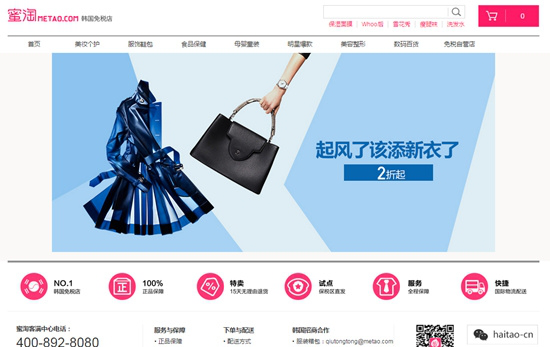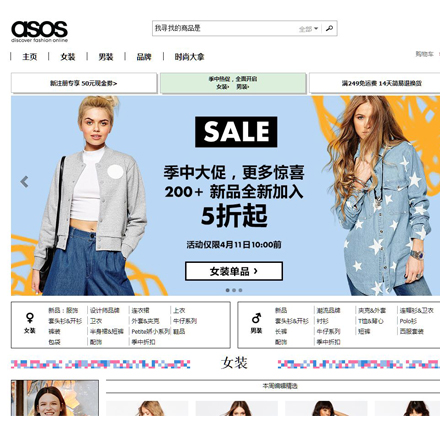Part Two - How to Survive in China's Cross-Border E-Commerce Industry
This week, we discuss the decline of cross-border e-commerce platform Metao and UK retailer Asos, highlighting what retailers shouldn't do when entering the market.
by Azoya Consulting
Last week, we highlighted how iHerb (health supplements), Kaola (direct retailing platform), and Feelunique (beauty & cosmetics) were able to succeed in China's e-commerce market.
This week we are releasing part two, which chronicles the decline of failed CBEC platform Metao and UK retailer Asos.
Metao (2014-16)
Metao, one of China’s first cross-border e-commerce platforms, shut down in 2016 after bleeding from heavy losses. Its direct retailing, deep discounting business model required large amounts of capital that couldn’t be sustained in the face of competition from larger players.
Metao’s founders had previously worked for Alibaba’s Tmall platform, and sought to create a strategic alternative to China’s daigou industry, in which small gray market sellers purchase highly coveted products overseas and re-sell them to Chinese consumers at a mark-up, bypassing import tariffs and lengthy product registration processes.

Metao's old platform
Phase 1 - Shopping Guide Business Model
The platform began as a shopping guide and order syncing tool that helped Chinese customers discover and purchase products directly from abroad; Metao collected a small service fee from the overseas merchants it worked with.
However, the downside with this model was that poor management of logistics and customs clearance processes resulted in a refund rate of over 60%. Metao had used a complex freight forwarding service and had little to no control over the logistics experience.
Phase 2 - Direct Retail E-Commerce + Flash Sales
To make up for this weakness in the supply chain, Metao secured more funding from outside investors to purchase its own inventory and build its own supply chain, selling top-selling products to customers through daily discount campaigns, not unlike VIP.com. Registered users rose to over a million, and monthly GMV surpassed 10 million RMB towards the end of 2014.
However this model was unsustainable in that overseas brands and retailers weren’t as desperate as domestic brands to clear inventory through discount deals; their inventory stock wasn’t as deep, goods sold out too quickly, and they couldn’t be replaced due to their cross-border nature, negatively impacting the customer experience. Selling at deep discounts also made it difficult for Metao to recoup higher cross-border logistics costs.
Additionally, as the likes of Jumei, VIP, and Tmall Global entered the field, traffic and user acquisition costs soared, and the company, unable to compete in an industry-wide price war, began to lose large amounts of money.
Phase 3 - Korea-Only Vertical
Metao pivoted its business model to focus on directly procuring from Korean brands only, in order to lift margins, but its operational costs were still too high and other platforms such as Tmall, JD, and Rakuten had already set up strategic partnerships with many of the big brands there.
In the end, Metao reverted back to its shopping guide model before closing up shop in April 2016. The amount of capital required to maintain a sustainable, cross-border retailing model was too much and Metao simply had no competitive edge over its peers.
What retailers should learn from Metao’s decline is that 1. the flash sales model is difficult to operate for a cross-border e-commerce business, 2. moving too quickly to a bonded warehousing model can be costly and disastrous, and 3. niche platforms that only focus on selling one category’s or one country’s products have to be able to play their niche better than general platforms can.
RECOMMENDED READING How JD.com is Priming Itself for Global Expansion By Azoya Consulting |
Asos (2013-16)
British online fashion retailer Asos quit the China market in 2016, after investing 100 million RMB over a three year time frame. The online fashion retailer had set up a standalone e-commerce site and Tmall store in 2013.

Asos' old Chinese site
Asos’s mission was to become the number one fashion destination worldwide for young millennials in their 20s. In China, however, it ran into significant merchandising and product localization issues that could’ve been prevented with a little more due diligence and market research. In the end, Asos ended up taking a ten million pound loss when it withdrew from the market.
Why Fashion Apparel is So Difficult to Do Cross-Border
In general, fashion apparel is difficult to pull off with cross-border e-commerce in China. The items are non-standardized due to the different sizes and colors of each product, and the return rate is higher because of fit issues.
For cross-border e-commerce, there needs to be a clear reason why consumers should buy an international brand over a local brand because of the logistics costs and delivery times. With categories such as health supplements and cosmetics, the difference is clear because of the raw materials involved, but with apparel the advantages are international brands are less clear-cut.
Limited Product Selection Fails to Arouse Demand
As a direct retailer, Asos’s product selection was limited as it was difficult to replicate its wide product selection in a new market; it was only able to offer around 5,000 products, compared to the 80,000 it offered on its UK site. Many Chinese customers complained that the selection consisted of too many accessories and unwanted inventory from the UK.
Dresses accounted for over 40% of fashion-related search terms in China; yet they accounted for less than 10% of the Asos product mix. Additionally, the limited range made it difficult to satisfy customers from different regions in China, as the weather in northeastern China differs dramatically from that of southern China.
What’s more is Asos attempted to differentiate itself by selling niche British brands and its own private label brands; however, these brands had little prior exposure in the China market and it was difficult to justify the need for them when the likes of Zara, H&M, and Uniqlo had already been present for years.
RECOMMENDED READING What Does Topshop's Breakup with Shangpin Tell Us About Fashion Retail in China? By Azoya Consulting |
Asos Runs Into Operational Issues
Asos also had significant issues with getting its products registered in China. In a bid to improve the customer experience, it moved from cross-border e-commerce to general trade, stocking large amounts of inventory in Chinese warehouses, but this meant that it had to alter its clothing labels to adhere to local regulations. Its products had to undergo stringent testing requirements, and extra costs were passed on to local Chinese consumers.
For many people in China, this was a deal killer because consumers are naturally inclined to purchase cheaper items abroad, and are willing to wait until their next overseas trip or use daigou agents. Today, cross-border e-commerce has narrowed the price gap and provided another channel for Chinese residents to purchase overseas goods without exceedingly high import tariffs
Nevertheless, Asos’ departure from China leaves us with the lesson that 1. fashion apparel companies should carefully gauge whether there is a real need for their products before entering the China market, 2. Multi-brand retailers should offer a wide assortment of products to attract customers, and 3. if entering the China market, they need to localize their products to adhere to the tastes and habits of Chinese consumers..
The Road Ahead – What Brands And Retailers Should Do To Succeed in China Cross-Border E-Commerce
E-commerce in China is becoming increasingly crowded and challenging. Today’s consumers are now highly sophisticated and though they are willing to try new things, international brands and retailers need to think harder about how they want to differentiate themselves and whether or not they have the capabilities and resources to provide a strong e-commerce experience. Here’s a few tips.
International retailers should properly gauge Chinese demand for their products before deciding to enter the market.
Just because China is a big market doesn’t mean people will necessarily buy your products. The market is increasingly competitive and there needs to be a specific reason why Chinese people will purchase your foreign brand over a local domestic brand.
For industries such as mom & baby and health supplements, the value of a foreign good is more clear-cut because Chinese people see them as safer, but for a category such as fashion apparel it’s harder to say. Brands should check and see if there are already small mom and pop retailers or daigou selling their products on Taobao, and also see if there is any social media buzz on Little Red Book and WeChat.
Retailers need to provide a better logistics experience, especially for those on large marketplaces.
Marketplaces such as Tmall Global and Little Red Book, wanting to provide the best customer experience, are placing increasingly demanding requirements on third-party store operators when it comes to speedy fulfillment and delivery.
After gaining traction, brands can think about stocking their more popular goods in Hong Kong, which shortens cross-border delivery to 3-5 days.
International brands and retailers need to rethink their merchandising strategies.
Chinese consumers are becoming more and more sophisticated. Overseas retailers can’t just sell out-of-season, clearance items that consumers in their home markets don’t want; Chinese customers won’t buy them either. Offering a broad assortment of goods that include both top-selling SKUs and emerging brands can be a good strategy to start off with.
Brands should leverage content marketing to build their brand and differentiate themselves.
In an increasingly crowded market, brands need to craft a unique message that demonstrates why consumers should choose them over local competitors, especially if they are to purchase through cross-border e-commerce where the shipping times are longer. This is especially hard to do on a marketplace where products are listed next to competitors and users are likely to pick the cheapest product with the highest number of quality reviews.
Both WeChat and Little Red Book provide avenues for brands to communicate their value proposition and educate customers. The development of WeChat mini-programs has enabled brands to carry out more creative marketing campaigns and integrate content with commerce.